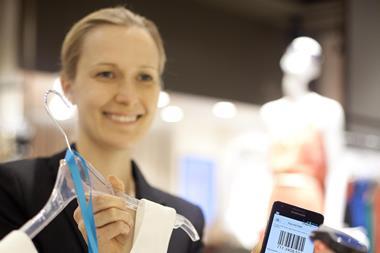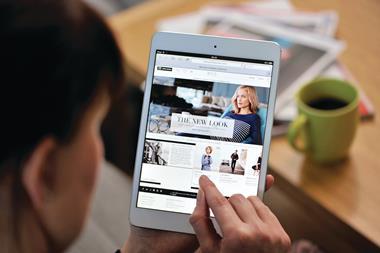The rising tide of social media platforms has transformed the way people communicate and the way retailers must engage with customers.

When you have 53 million loyal monthly users worldwide, you’re a hot prospect for a marketer. Pinterest, the latest social media sensation, has gained instant cult status with its simple yet irresistible appeal.
And, in December, the network made its first big appearance in UK retail in a collaborative campaign with Topshop – ‘Dear Topshop…’ – which allowed shoppers to pin pictures straight from the retailer’s website onto their own Pinterest board.
The reason for Pinterest’s success is down to doing the two things that all social media tries to do: it lets people make it their own and then share their creation with friends.
With fashion and identity such fundamental parts of youth culture, inevitably photographs of clothes, accessories and catwalk shows are being shared by the million. No wonder retailers are so interested.
Topshop marketing director Sheena Sauvaire says the Pinterest technology provided a way for the retailer to track “the most coveted items” on its website.
“We then used this data to highlight those key items in store and online,” she adds. “This gave us another insight into how crowd-sourced recommendations can drive purchase in the physical space. The results were positive and I think it shows how peer-to-peer influence continues to be a driving factor, particularly for the younger shopper.”
Tapping into potential
It’s one thing to see the potential in social retailing, but it’s quite another to successfully tap into it. With so much scope for success or failure every minute of the day, how can retailers make social media work for them, and avoid the pitfalls in the process?
By the end of this year, more than 75% of the UK population will be using a smartphone. That’s a lot of connections in a massive network of mobile phone users, and potential shoppers. M-commerce is nearing maturity, social media is ubiquitous, and a new generation is already adept at multichannel shopping.
With so many strands of technology and media, retailers have a big task on their hands trying to pin it all down. The key question now, it seems, is how to make it all join up.
eBay vice-president of UK marketplaces Tanya Lawler says: “This year we’ll see an even bigger drive towards integration of social media and peer-to-peer recommendation.
“Crowd-sourced shopping inspiration – such as Topshop’s partnership with Pinterest – shows the power of social in inspiring people to buy, while PayPal’s Check-in app allows retailers to build relationships with local customers in store. There’s a huge opportunity for brands to capitalise on the sweet spot between utility and engagement.”
The scale of opportunity is clear, but it is possible only because technology has moved on so quickly. As this continues so will the ways for retailers to interact with shoppers.
David Jones, director of creative technology agency Digital Avenue, says: “The advent of 4G networks and an increase in wi-fi connectivity has enabled content-rich
applications and campaigns to be launched across mobile. This means campaigns that
were previously limited and gimmicky are now able to offer rich, informative and dynamic content to customers.”
Social innovation
With this wealth of rich content available and the technology in place to make it run fast enough for integrated social retailing, the year ahead is likely to bring more exciting link-ups to follow Topshop’s innovation. For retailers, however, it’s not just about getting people talking and sharing, but about converting this interaction into sales.
Worth Retail managing partner Alex Johns, who is behind the Worth Foundation competition to find talented new retailers, believes this is where brands are looking for the next big solutions. “While all big retailers have some sort of social strategy, nobody has quite worked out how to convert all these ‘likes’ and retweets into sales,” he says.
He believes that there is now an opening for integrated platforms, such as Storystream, which allow retailers to compile and curate all their customers’ social activity into one stream and build a marketing campaign around that.
“It enables them to turn what would otherwise be rather piecemeal social media mentions into a comprehensive marketing campaign that harnesses the power of social media buzz in a much more strategic way,” he says. “It creates compelling material that has all the credibility of peer social media endorsement and is therefore more likely to lead to sales.”
With so much advancement in online innovation, it’s easy to think that physical space is becoming redundant. This is not the case, according to eBay’s Lawler, who says the experience and entertainment aspects of physical retailing are still just as important.
She says: “It is less about fulfilling a mission – a need – and more about fulfilling passion – a want or a love – and that’s where social shopping comes in.”
In fact, Jones says, with technology moving much faster than physical store design, brands are starting to base their store experience on customers’ online experience.
“Bricks-and-mortar stores should be harnessing advancements in mobile technology, which will enable them to offer the sort of personalised and focused experiences that customers have previously only expected from online retail.”
The social network era has changed everything – from the way people communicate and shop, to how marketing is carried out, and even how impatient people have become.
But certain fundamentals remain. When people love an item or a brand, they will talk about it and share the experience. Social retailing, then, has always existed, but for the first time the means – and the media – are in place to make it possible for a retailer to take an active part in the conversation.
Social activity monitoring brand buzz
When it comes to social media, monitoring what’s being said about a brand is only part of the job. Live feeds update every second, media users interact with a brand 24 hours a day and, according to KANA Software’s Impatience Index, the average user’s “expectation reflex” – when they expect a response from a business – has drastically shrunk.
The survey, published earlier this year, found that a fifth of smartphone users check their devices at least once an hour, and one in 20 admitted to checking it at least once every 10 minutes.
Keeping up with this is a full-time business and Richard Goodall, group sales and marketing director at PCMS, believes there are potential traps. “There are a lot of pressures,” he says. “There can be a lot of negative comments on Facebook and Twitter, and if a conversation goes badly wrong and the customer is offended, it might end up in the Daily Mail.
“Lots of retailers like Ann Summers are proactively going out there and using social media to drive brand identity and it’s generally very positive. But they have to be prepared for the negative as well.”
The retailers that are able to manage this and build an integrated system in which the media ties in with the store experience will make gains early on. Many already have, such as Next, Argos and House of Fraser.
But however hard it is, Digital Avenue’s David Jones says having technology in their physical space is going to be a must for retailers seeking to succeed in social retailing. He observes: “Augmented reality virtual fitting rooms, combined with social media feedback can become a powerful tool in helping retailers gain brand exposure while driving sales. Integrating photographic-centric social media such as Instagram, Pinterest or Tumblr into their websites will allow brands to refine their product range and buying strategy.”

























No comments yet